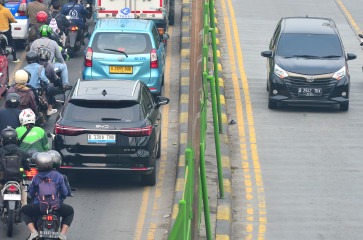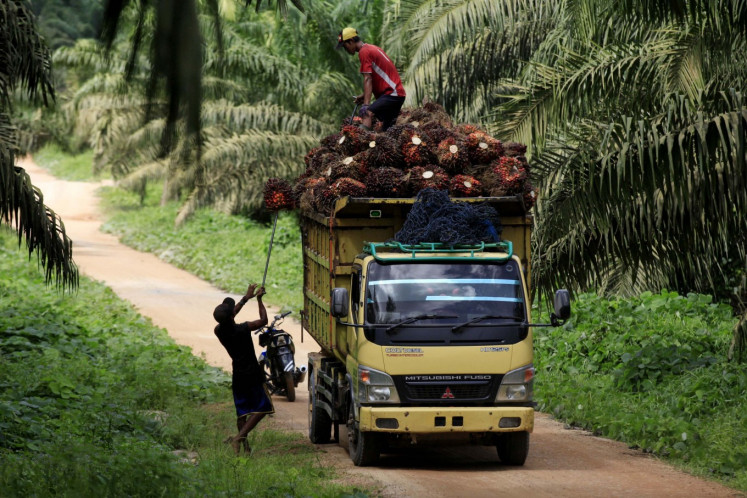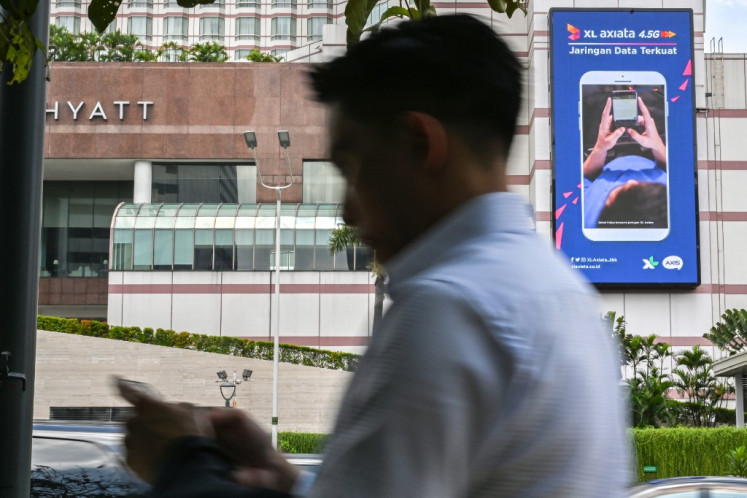Popular Reads
Top Results
Can't find what you're looking for?
View all search resultsPopular Reads
Top Results
Can't find what you're looking for?
View all search resultsExperiencing Brazilian dance in the City of Samba
Cheerful: A young dancer shows off her samba flair to spectators at the Academicos do Grande Rio Samba school in Rio de Janeiro, Brazil
Change text size
Gift Premium Articles
to Anyone
Cheerful: A young dancer shows off her samba flair to spectators at the Academicos do Grande Rio Samba school in Rio de Janeiro, Brazil.
Samba is a Brazilian musical genre and dance style originating from Africa. It has become a national icon with the annual Sambadrome carnival in Rio de Janeiro gaining worldwide popularity. On the sidelines of the 2016 Olympics in Rio de Janeiro, The Jakarta Post’s Musthofid — at the invitation of Olympic timekeeper Omega — visited the City of Samba for a complimentary performance and joined dancers from a samba school for a parade.
Music reverberated in the open air with the distinctive sound of tambourines as we alighted from buses in an area not far from downtown. Dancers, dressed in colorful samba costumes alongside stationary floats, swung their bodies and twisted their limbs to the beat.
A young girl in a bikini instantly and enticingly became more vigorous in her no pe (foot samba) as a camera focused on her.
After being presented with a spell of a stage performance, during which the audience was given the chance to get involved by beating on tambourines, we tried on samba costumes and mingled with the dancers for an outdoor parade that made the front yard of the Academicos do Grande Rio Samba school look like the Sambadrome stage.
Some guest performers looked shy upon being asked to follow the dancers’ movements, while others had no reservations about engaging with the tune from the musical troupe.
It was a quarter of an hour samba experience for the visitors.
“Here we are in the City of Samba. Look around and see all these warehouses. They are schools of samba of Rio de Janeiro,” Jay Brown, a school official, told The Jakarta Post while pointing at buildings in the area.
The area is called Cidade do Samba Joãozinho Trinta (the City of Samba), and houses the city’s top samba schools.
“They [the city administration] created this area for all the schools of samba from the special group. It is a very special place dedicated to carnival and the top schools of samba of Rio de Janeiro. Therefore the name fits perfectly, as we know that there is no carnival without samba,” Brown said.
Besides Grande Rio, the other 11 schools in the top league are Mangueira, Beija Flor, Salgueiro, Portela, Unidos de Tijuca, Mocidade, São Clemente, União da Ilha, Vila Isabel, Imperatriz and Paraiso do Tuiuti.
“It’s like football. During the carnival, it’s a competition. The one that finishes in 12th place is the loser. It will go to the lower league. The winner of the lower league is promoted to the top league.”
He was standing by a float prepared for the Sambadrome carnival. Other floats of different sizes and designs were being constructed inside the school building.
In one corner, samba costumes of various colors were on display.
He pointed to a float that would be used by the Santos soccer club’s players during the parade.
“This is a room for the Santos players,” he said, indicating a chamber inside the float. It had a ramp at the back, which, he said, the players would run down during the carnival.
Sponsorship is crucial with preparations for the carnival costing between US$4 and $5 million, while the city of Rio can only provide each of the schools with a $2.5 to $3 million cash subsidy.
“So what do we do? We get small money from the government and find sponsors. All the floats here tell the story of sponsors,” he said, adding that the city of Rio could make $900 million during the carnival season.

Welcome to City of Samba: A dancer acknowledges spectators while performing on a float.
The carnival runs for five days in February at the 700-meter-long Sambadrome with a capacity of 90,000 spectators in Marquis de Sapucaí. Two days are allotted for the parade — six schools per day.
Historians agree that the carnival in Rio de Janeiro took place as early as 1723 with the first official parade recorded in 1935 at Praça Onze. The event remained at that location for 30 years until it was moved to the Avenida Presidente Vargas and finally to where it takes place today.
Speaking of history, Brown said the samba carnival used to be a rare chance for lower-income people to gather and party.
“Until 1888 black people in Brazil were slaves. These slaves were only free to have parties or dance during carnival time, each year. This is why until today you will find a big connection between poor communities and all the top samba schools,” he said.
“The samba school gives a lot of pride to the community. And this is what carnival is all about [...] a day when a rich CEO goes on the streets dressed like a homeless person, and a poor person dresses like a king. Samba was born from such history.”
The Sambadrome carnival next February will surely draw tourists once again to watch and try out the iconic Brazilian dance. For some Olympic visitors, the experience in the City of Samba was a prelude to the real parade.
— Photos by JP/Musthofid
------------
We could take samba carnival to Indonesia, says Brown

Propping up the parade: Jay Brown poses by a prop prepared for next year’s Sambadrome carnival. (JP/Musthofid)
The samba carnival at the Sambadrome Marquês de Sapucaí is an occasion for everyone to come together and have fun. Jay Brown, an official of the Academicos Do Grande Rio, one of the top 12 samba schools in the city, told The Jakarta Post about the samba, the carnival and their history. The excerpts are below.
Question: Is the Sambadrome the only place to see the samba in Brazil?
Answer: Samba is everywhere […] in the streets, in clubs and in people’s hearts. The Sambadrome is the stadium for the competition between the best leagues of samba schools in Rio de Janeiro. Each and every city of Brazil has its own way of celebrating the carnival. In São Paulo, they also have a Sambadrome and a smaller City of Samba where their samba schools parade. You also have to understand that, apart from the samba school competition during the carnival, there are also hundreds of street parties all over the city called bloco.
We were presented a series of performances on the floats inside the building. Are they part of the real performances during the carnival?
Part of the performance that you saw was indeed what happens during the carnival, but a fair part of what happened on the floats during the show was created especially for our special guests.
Do the samba schools give lessons on samba dance to people interested in participating in the carnival?
There is no need for it. People learn how to dance the samba before they can walk. That’s because their mothers take them to samba parties even before they are born and are still in their mothers’ wombs.
How do people join your school for the carnival?
People from our community who want to parade with us during the carnival need to come to each rehearsal three times a week, from August until the day of the carnival. Each year, about 12,000 people from the community want to parade with us, and only about 5,000 to 6,000 are chosen. If for any reason they miss just one rehearsal, they lose their place and someone replaces them.
How long do you prepare for a carnival, which takes place in February every year?
It takes a full year to prepare for the carnival. From the end of a carnival until June, we dismantle floats from the carnival. In August, we need to have a new storyline and sponsors for the upcoming carnival. By October, we must have the designs, such as for costumes, and then we put everything together and have to be ready for the carnival.
What’s the specific nature of the samba compared to other dances like, for example, the tango of Argentina?
The samba is based on an Afro-Brazilian rhythm and was brought to Brazil by African slaves.
What does the samba mean to Brazilians?
The samba spread in Brazil as the first African-Brazilian culture, after 400-years of slavery. The samba became a symbol of liberation all over the country. In Brazil, music plays a vital role in society, and the samba is the most popular music style and symbol associated with the Brazilian nation. The samba is simply a way of life. It certainly means a lot to Brazilians, as well as love, roots, energy, passion and warmth. Actually it means everything.
What is the significance of the samba carnival to Brazil tourism?
The Rio samba school parade is the biggest and by far the best in the world. It is transmitted all over the world and is a huge marketing platform for the city of Rio de Janeiro and anyone associated with it. Also, the city of Rio makes about US$900 million each year in revenue from the carnival, which is gained from sponsors, TV broadcasting rights, entrance tickets and other things. Furthermore, there is a huge turnout by Brazilians and foreigners to attend the Sambadrome each year, and therefore the city’s hotels are full and restaurants and tourist attractions see bigger attendance. The Rio carnival is an amazing show that must be seen live at least once in a lifetime and I invite all Indonesians to make it here to Rio, during the carnival. We would be happy to entertain them.
Do you go overseas for samba performances?
Our samba school has a tourist project called Carnival Experience in which we give dance and percussion workshops and shows for tourists who are interested. From time to time we are invited to take the carnival to other countries like Japan and Germany. We could also take the carnival to Indonesia.
Should there be a chance to take the samba carnival to Indonesia, what would be the requirements?
For shows abroad, it’s always possible and solely depends on the requirements of the clients, as Grande Rio can provide a fantastic one-off performance. So the important question is how many dancers, performers and/or percussionists are needed and how long the performance will need to be. In general, Grande Rio and its performers are available with their costumes and their musical instruments, while the client takes care of their airfares to and from Brazil, daily meals for the performers during their stay, accommodation in a decent hotel, shuttle to and from show venue, a daily performance fee for each artist present and a fee for the school.










